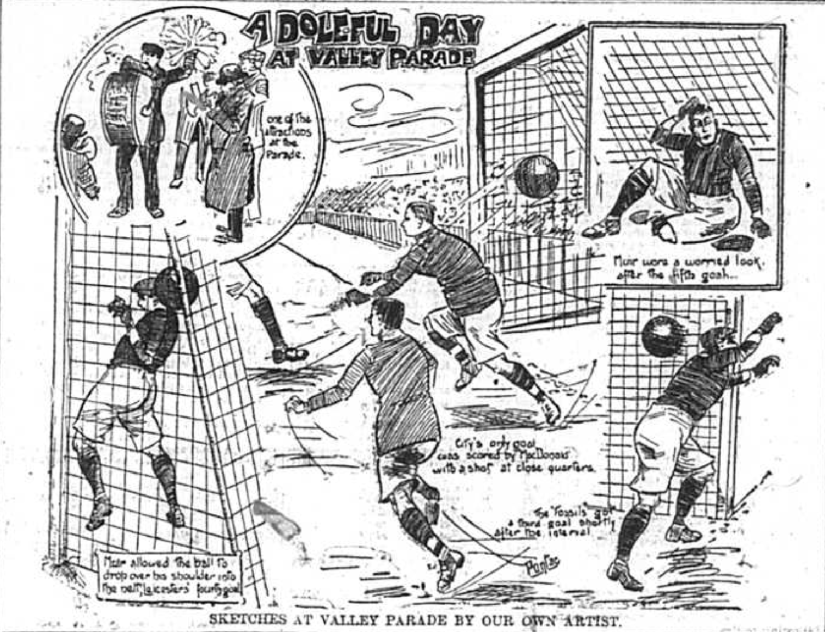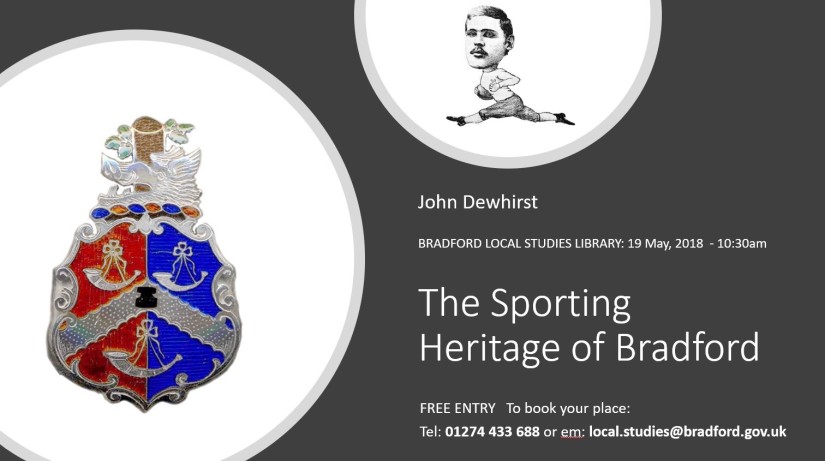My feature published in the Bradford City AFC programme vs Milton Keynes on 24th April, 2018.
On 7th March, 1908 Bradford City played Leicester Fosse at Valley Parade. Prior to the game the club sat at the top of Division Two, on course for joining the elite of English football only five years after being elected to the Football League.
City supporters were in a confident mood, their team unbeaten in six games that included a sequence of three consecutive victories: 6-2 (Wolves, home); 5-1 (Gainsborough, away); and then 5-0 (Stockport, home). With 28 games played City had won 18 and been defeated on only five occasions. The City goal average was the highest in the division and the team had scored a total of 68 goals including an opening day 8-1 thrashing of Chesterfield, a 5-0 defeat of local rivals Leeds City and then a 7-1 win over Gainsborough Trinity (all of which at Valley Parade).
Leicester Fosse came to Valley Parade in 8th place. Nevertheless, with a strong home record and 11 wins from 13 games and only a single loss, most people expected Leicester to be defeated. The fact that City had been held 2-2 away at Glossop North End in their previous game tended to be overlooked.
Can anyone guess what happened? Bradford City being Bradford City, they suffered a 1-5 reverse! A cartoon in the Bradford Daily Telegraph described the outcome as a doleful day at Valley Parade and it certainly wouldn’t be the last.

To make matters worse, in their following match City lost 1-2 at Blackpool, like Glossop another club struggling at the foot of the division. Although Stoke City were defeated 6-0 in the next game at Valley Parade, in the last fixture of the month on 28th March, City lost 2-3 at West Bromwich Albion. A 1-1 draw against Grimsby on 4th April left the club in third place in the table behind Oldham Athletic and Derby County with five games left. Nevertheless it remained tight, with City only a point behind the leaders.
City eventually finished as champions of Division Two and did so by winning each of their remaining games. Promotion was all but sealed following victory in the penultimate fixture of the season against Burnley at Valley Parade in front of a 27,000 crowd but it was guaranteed with a home victory over Lincoln City in the final match. The season ended with City four points clear of runners-up, Oldham and 90 goals scored in 38 games.
The manner in which the team prevailed after the wobble in March helped define a new club legend. It instilled a self-belief that allowed Bradford City to consolidate in the first tier the following season.
The achievement of winning promotion was considered vindication for the decision to reject merger – and with it, relocation to Park Avenue – at the end of May, 1907. However, the promotion of Bradford City opened the way for Bradford Park Avenue to be elected to the Football League. Previously there had been outright opposition to Bradford having two clubs in the second division but the success of Bradford City was used to support the case that Bradford was a hotbed of soccer enthusiasm.
Having secured membership of Division One, Bradford City embarked on an ambitious ground development programme that incorporated new offices on Burlington Terrace with a tunnel from the dressing rooms and the construction of a grandstand on the Midland Road side.
Peter O’Rourke had been appointed secretary-manager in November, 1905 and was also the man in charge at the time of the FA Cup victory in 1911. His signing of Frank O’Rourke and James McDonald in April, 1907 was said to have been decisive in strengthening the squad and Frank O’Rourke was later credited for having transformed an average side into a championship team the year later. In fact, Frank – no relation to Peter – scored 21 of the team’s goals in 1907/08.
In August, 1907 another key player, Robert Torrance had been signed from Kirkintilloch Rob Roy although he did not make his debut for the first team until the following season. Alongside Frank O’Rourke and James McDonald, Torrance played in the 1911 FA Cup Final replay to win the trophy. On 24th April, 1918 at the age of 30, Torrance was killed at Ypres whilst serving with the Royal Field Artillery. Two members of the Bradford City squad in 1907/08 were also killed in World War One: Harry Hanger (36 League & cup appearances) and Gerald Kirk (3).
—————————————————————————————————————————-
- Read more about the early history of Bradford soccer in my books ROOM AT THE TOP and LIFE AT THE TOP If you are interested in Bradford sport history visit VINCIT: https://www.bradfordsporthistory.wordpress.com
—————————————————————————————————————————–
Thanks for visiting my blog. Apart from publishing my BCAFC programme articles I also upload occasional articles of historical interest. Scroll down for details about my books in the BANTAMSPAST History Revisited series which tell the history of sport in Bradford – and in particular football. The books seek to explain why things happened as they did instead of simply recording what occurred and readers may be surprised at the extent to which they contradict many of the myths and superficial narratives that have circulated previously.
Links to other articles written by myself on the history of football and the origins of sport in Bradford HERE
On Saturday 19 May, 2018 I am giving a talk in the Bradford Local Studies Library on the origins of spectator sport in nineteenth century Bradford and the development of the city’s sporting culture and identity. This will cover principally cricket, rugby and football and include a Q&A session.

Tweets @jpdewhirst

